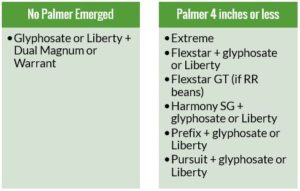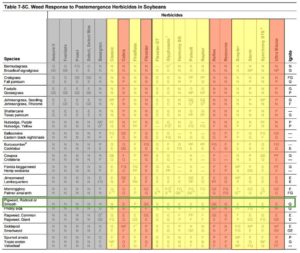A cool, wet spring, followed by heat and sun has led to the perfect storm for weed development over the last few weeks. As weeds begin to grow, timeliness of post-emergence applications is critical to suppressing weed populations and protecting the soybean yield.
While there has been some late-season horseweed in soybean fields this year, Palmer continues to be the biggest problem for North Carolina growers. It was recently voted the “worst weed in America” by the Weed Science Society of America. A single Palmer amaranth female can produce a half-million seed and the plants can grow over an inch per day.
Glyphosate-resistant Palmer amaranth is widespread across most of N.C., and growers are encouraged to assume all Palmer amaranth is resistant and plan treatment programs accordingly. ALS resistance is also common, and Dr. Alan York speculates that most of the Palmer populations in the state are resistant to both. With glyphosate- and ALS-resistant Palmer, post-emergence options for Palmer amaranth control are essentially limited to PPOs and glufosinate (Liberty/Ignite).
As post-emergence herbicide applications are planned, remember timeliness is critical. Palmer amaranth should be treated before it exceeds four inches tall. Treating larger weeds results in less control and will accelerate the selection for resistance to PPO inhibitors. Some post-emergence herbicide options are listed below.

PPO-resistance has not officially been documented in N.C., but it is evident some pockets exist and is in the process of being officially confirmed. Soybean growers cannot afford to lose PPOs as this would leave Liberty as the only option for post-emergence control of Palmer amaranth. Below is the “Weed Response to Postemergence Herbicides in Soybeans” from the 2016 North Carolina Agricultural Chemicals Manual (p. 273). Herbicides that are not effective for control of Palmer (ACCASE Inhibitors, & Photosynthesis Inhibitors) are shaded in gray. Products with glyphosate or ALS inhibitors, to which most Palmer is already resistant, are shaded in red. PPO inhibitors are shaded in yellow. The only herbicide not highlighted is Ignite (Liberty). This demonstrates how critical it is to not lose PPOs.

To avoid more resistance problems, it is essential growers are vigilant when it comes to weed control. Remember these tips when planning for weed control.
[ordered_list]
- Start with clean fields with proper burn down
- Get pre-emergence herbicides out quickly after planting, don’t wait four or five days because beans are already emerging by that point
- Make timely applications and use full-application rates
- Rotate chemistries
- Don’t ignore escaped weeds
- Think beyond herbicides and diversify approaches to weed management
[/ordered_list]
For more resources on weed management visit www.takeactiononweeds.com. Together we can work to make NC weed free.
This article was adapted from resources published by NCSU Weed Science Extension Specialists Dr. Wes Everman and Dr. Alan York at https://soybeans.ces.ncsu.edu/wp-content/uploads/2013/04/GR-Palmer-Amaranth-Control-in-Soybeans.pdf?fwd=no.






